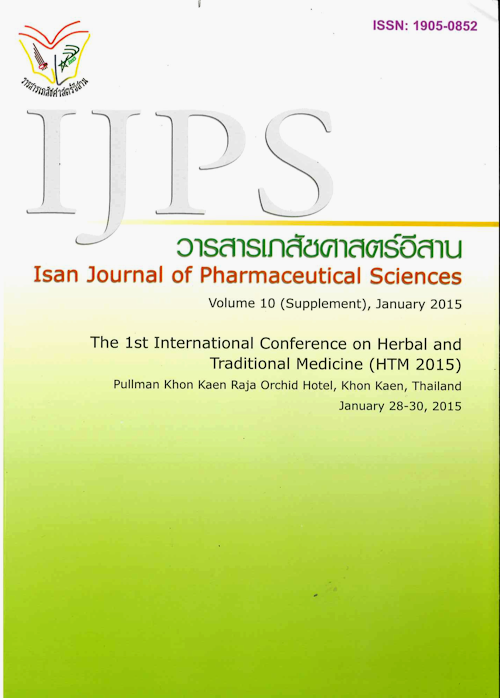Superoxide Anion Scavenging Activity and Mitochondrial toxicity of Various Tamarind (Tamarindus indica L.) Seed Coat Extracts
Main Article Content
Abstract
from natural products or their derivatives. Tamarind seed coat is also well known in health benefi ts
such as anti-oxidant activity, anti-infl ammation and anti-diabetic but anti-cancer is rarely. Thus, this
study was to investigate the extraction condition and effects on cellular toxicity of Tamarind seed coat.
Methods: Extractions with super critical CO2 with ethanol co-solvent as well as with ethanol and water
extraction were carried out. The effects of Tamarind seed coat extracts on superoxide anion scaveng
ing activity and mitochondrial toxicity were determined. The supercritical extraction was performing with
various ethanol co-solvent. The solvent extracts were obtained from 50 and 95% ethanol and water
used as a polar phase of extraction. Seven extracts were obtained and free radical scavenging activ
ity was determined by superoxide dismutase (SOD)-like activity assay. The mitochondrial toxicity was
analyzed by mitochondrial dehydrogenase activity (WST assay) and mitochondrial membrane potential
(MMP assay). Results: All extracts exhibited high potential of superoxide anion scavenging activity
over the IC50 range <5-25 μg/ml. WST assay was analyzed on various cells culture as well as Caco-
2, HepG2, Hela, L929 and HK-2. The MMP assay was further investigated on Hela cells by fl uorescence
technique. Interestingly, the tamarind seed coat with water extract showed the highest toxicity to
cancer cells but not to normal cells. The IC50 of water extract that exhibited on Caco-2, HepG2
andHela cells were 99.86, 81.15 and 15.06 μg/ml, respectively. The IC50 on normal cells (L929 and
HK-2) showed at 444.16 and over 1,000 μg/ml. The toxicity of water extract on mitochondrial membrane
was strongly as valinomycin (chemotherapeutic agent). Conclusion: From our fi ndings it was conclude
that tamarind seed coat extract from water may have strong toxic effect on cancer cells via mitocho
ndrial membrane degradation while no toxic effect on normal cells.
Article Details
In the case that some parts are used by others The author must Confirm that obtaining permission to use some of the original authors. And must attach evidence That the permission has been included
References
AravindSR, Joseph MM, Varghese S, Balaram P, et al. Antitumor and Immunopotentiating Activity ofPolysaccharide PST001Isolated from the Seed Kernel of Tama-rindus indica: An In Vivo Study in Mice. The Scientific World Journal 2012; 361382: 1-14.
Bhattacharya S, Bal S, Mukherjee RK, Bhattacharya S. Functional and nutritional properties of tamarind (Tamarindus indica) kernel protein. Food Chem 1994; 49: 1-9.
De M, De Krishna A, Baneerjee AB. Antimicrobial screening of some Indian spices. Phytother Res 1999; 13(7): 616-618.
Kulkarni AP, Aradhya SM, Divakar S. Isolation and identifi cation of a radical scavenging antioxidant–punicalagin from pith and carpellary membrane of pomegranate fruit. Food Chem 2004; 87: 551-557.
Luengthanaphol S, Mongkholkhajornsilp D, Douglas S, Douglas PL, et al. Extraction of antioxidants from sweet Thai tamarind seed coat––preliminary experiments. J Food Eng 2004; 63: 247-252.
Maiti R, Das UK, Ghosh D. Attenuation of hyperglycemia and hyperlipidemia in streptozotocin induced diabetic rats by aqueous extract of seed of Tamarindusindica. Biol Pharm Bull 2005; 28: 1172-1176.
Maiti R, Jana D, Das UK, et al. Antidiabetic effect of aqueous extract of seed of Tamarindusindica in strptozotocin-induced diabetic rats. J Ethnopharmacol 2004; 92: 85-91.
Nakchat O, Meksuriyen D, Pongsamart S. Antioxidant and anti-lipid peroxidation activities of Tamarindusindica seed coat in human fibroblast cells. Indian J Exp Biol2014; 52(2):125-32.
Nurhanani R, Sarni MJ, Amirah Fa, et al. Effects of various solvents on the extraction of antioxidant phenolics from the leaves, seeds, veins and skins of Tamarindusindica L. Food Chem 2012; 131 (2): 441-448.
Paula FS, Kabeya LM, Kanashiro A, et al. Modulation of human neutrophil oxidative metabolism and degranulation by extract of Tamarindusindica L. fruit pulp. Food Chem Toxicol 2009; 47: 163-170.
SiddhurajuP. Antioxidant activity of polyphenolic compounds extracted from defatted raw and dry heated Tamarindusindica seed coat. LWT 2007; 40: 982-990.
Sudjaroen Y, Haubner R, Wurtele G, et al. Isolation and structure elucidation of phenolic antioxidants from Tamarind (Tamarindus indica L.) seeds and pericarp. Food Chem Toxicol 2005; 43: 1673-1682.
TsudaT, Watanabe M, Ohshima K, et al. Antioxi-dative components isolated from the seed of Tamarind (Tamarindus indica L.). J AGR Food Chem1994; 42: 2671-2674.


